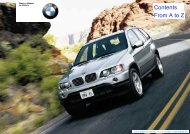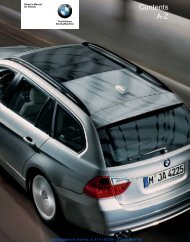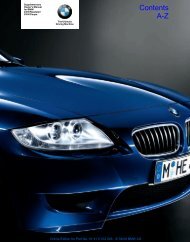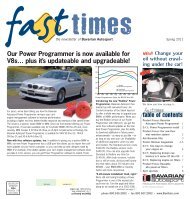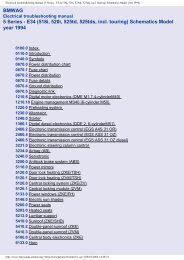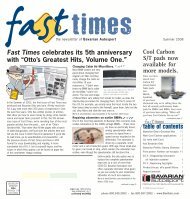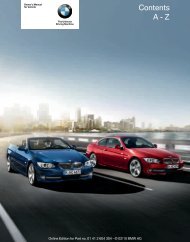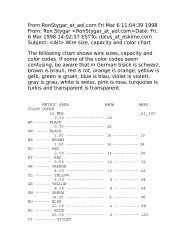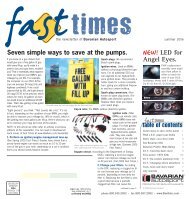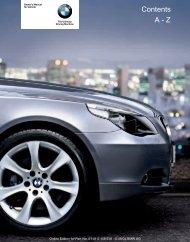Online Edition for Part no. 01 41 2 604 027 - © 03/10 BMW AG
Online Edition for Part no. 01 41 2 604 027 - © 03/10 BMW AG
Online Edition for Part no. 01 41 2 604 027 - © 03/10 BMW AG
Create successful ePaper yourself
Turn your PDF publications into a flip-book with our unique Google optimized e-Paper software.
Things to remember when driving<br />
Things to remember when driving<br />
Break-in period<br />
Moving parts need breaking-in time to adjust to<br />
each other. To ensure that your vehicle continues<br />
to provide optimized eco<strong>no</strong>my of operation<br />
throughout an extended service life, we request<br />
that you devote careful attention to the following<br />
section.<br />
Engine and rear axle differential<br />
Always obey all official speed limits.<br />
Up to 1,200 miles/2,000 km<br />
Drive at various engine and vehicle speeds, but<br />
do <strong>no</strong>t exceed:<br />
> Gasoline engine<br />
4,500 rpm or <strong>10</strong>0 mph/160 km/h<br />
> Diesel engine<br />
3,500 rpm or 90 mph/150 km/h<br />
Avoid full-throttle operation and use of the<br />
transmission's kickdown mode during these<br />
initial miles.<br />
From 1,200 miles/2,000 km<br />
The engine and vehicle speed can gradually be<br />
increased.<br />
Tires<br />
Due to technical factors associated with their<br />
manufacture, tires do <strong>no</strong>t achieve their full traction<br />
potential until after an initial break-in<br />
period. There<strong>for</strong>e, drive reservedly during the<br />
first 200 miles/300 km.<br />
Brake system<br />
Brakes require an initial break-in period of<br />
approx. 300 miles/500 km to achieve optimized<br />
contact and wear patterns between brake pads<br />
and rotors. Drive in a reserved manner during<br />
this break-in period.<br />
Following part replacement<br />
Observe the break-in instructions again if components<br />
mentioned above must be replaced<br />
after subsequent driving operation.<br />
Saving fuel<br />
The fuel consumption of your vehicle depends<br />
on various factors. Through a few simple steps,<br />
your driving style, and regular maintenance, you<br />
can have a positive influence on your fuel consumption<br />
and environmental impact.<br />
Removing unnecessary cargo<br />
Additional weight increases fuel consumption.<br />
Removing add-on parts after use<br />
Remove unneeded auxiliary mirrors, roof or rear<br />
luggage racks after use. Add-on parts attached<br />
to the vehicle impede the aerodynamics and<br />
increase the fuel consumption.<br />
Closing windows and glass sunroof*/<br />
pa<strong>no</strong>ramic glass sunroof*<br />
An open glass sunroof/pa<strong>no</strong>ramic glass sunroof<br />
or open windows likewise increase the drag<br />
coefficient and there<strong>for</strong>e the fuel consumption.<br />
Checking tire inflation pressures<br />
regularly<br />
Check and correct the tire inflation pressure as<br />
needed at least twice a month and be<strong>for</strong>e long<br />
trips.<br />
An insufficient tire inflation pressure increases<br />
the rolling resistance and thus increases the<br />
fuel consumption and tire wear.<br />
Driving off immediately<br />
Do <strong>no</strong>t allow the engine to warm up by leaving it<br />
running while the vehicle remains stationary.<br />
Instead, begin to drive at a moderate engine<br />
138



